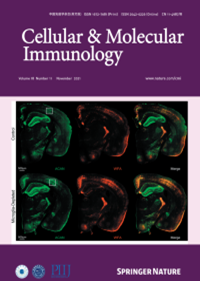CD8+GZMK+CD27+CCR7+ T cells mobilized by splenic sympathetic nerves aggravate brain ischemia‒reperfusion injury via CCL19-positive endothelial cells
IF 19.8
1区 医学
Q1 IMMUNOLOGY
引用次数: 0
Abstract
Splenic sympathetic activity critically modulates peripheral immunity after ischemic stroke, thus intervention in spleen sympathetic activity represents a promising therapeutic strategy for stroke. However, the mechanisms underlying spleen-brain-immune axis communication remain poorly understood. Here, we utilized a surgical denervation protocol to perform splenic sympathetic denervation (SDN), which significantly attenuated brain injury following stroke. Through single-cell RNA sequencing, we identified a novel GZMK+CD8+CD27+CCR7+ T-cell subset in patients with acute ischemic stroke (AIS), which we designated stroke-associated T (Tsa) cells. The expansion of Tsa cells was positively correlated with the severity of clinical symptoms and was driven by the splenic sympathetic nervous system. Stroke-induced sympathetic activation triggers the release of splenic norepinephrine (NE), which preferentially signals through ADRB2 on Tsa cells to promote their mobilization. Additionally, ischemic injury induces endothelial cell-specific expression of CCL19, which chemoattracts Tsa cells into the brain parenchyma via their cognate CCR7 receptor, exacerbating neuroinflammatory injury and neurological deficits in a transient middle cerebral artery occlusion (tMCAO) mouse model. We developed a CCR7-targeting peptide to disrupt this chemotactic axis and reduce T-cell infiltration, thereby mitigating brain injury. Our findings highlight SDN as a promising therapeutic strategy to attenuate ischemia‒reperfusion injury and suggest its potential as an adjunctive therapy for reperfusion treatment in AIS patients.

脾交感神经动员CD8+GZMK+CD27+CCR7+ T细胞通过ccl19阳性内皮细胞加重脑缺血再灌注损伤。
脾交感神经活动对缺血性脑卒中后的外周免疫具有重要调节作用,因此干预脾交感神经活动是一种很有前景的脑卒中治疗策略。然而,脾-脑-免疫轴通讯的机制仍然知之甚少。在这里,我们采用外科去神经方案进行脾交感神经去神经(SDN),这显著减轻了脑卒中后的脑损伤。通过单细胞RNA测序,我们在急性缺血性卒中(AIS)患者中发现了一个新的GZMK+CD8+CD27+CCR7+ T细胞亚群,我们将其命名为卒中相关T细胞(Tsa)。Tsa细胞的扩增与临床症状的严重程度呈正相关,并受脾交感神经系统的驱动。卒中诱导的交感神经激活触发脾去甲肾上腺素(NE)的释放,NE优先通过ADRB2信号传导Tsa细胞,促进其动员。此外,缺血性损伤诱导内皮细胞特异性表达CCL19, CCL19通过其同源CCR7受体将Tsa细胞化学吸引到脑薄壁,在短暂性大脑中动脉闭塞(tMCAO)小鼠模型中加剧神经炎症损伤和神经功能缺损。我们开发了一种靶向ccr7的肽来破坏这种趋化轴,减少t细胞的浸润,从而减轻脑损伤。我们的研究结果强调SDN是一种很有前景的治疗策略,可以减轻缺血-再灌注损伤,并提示其作为AIS患者再灌注治疗的辅助治疗的潜力。
本文章由计算机程序翻译,如有差异,请以英文原文为准。
求助全文
约1分钟内获得全文
求助全文
来源期刊
CiteScore
31.20
自引率
1.20%
发文量
903
审稿时长
1 months
期刊介绍:
Cellular & Molecular Immunology, a monthly journal from the Chinese Society of Immunology and the University of Science and Technology of China, serves as a comprehensive platform covering both basic immunology research and clinical applications. The journal publishes a variety of article types, including Articles, Review Articles, Mini Reviews, and Short Communications, focusing on diverse aspects of cellular and molecular immunology.

 求助内容:
求助内容: 应助结果提醒方式:
应助结果提醒方式:


